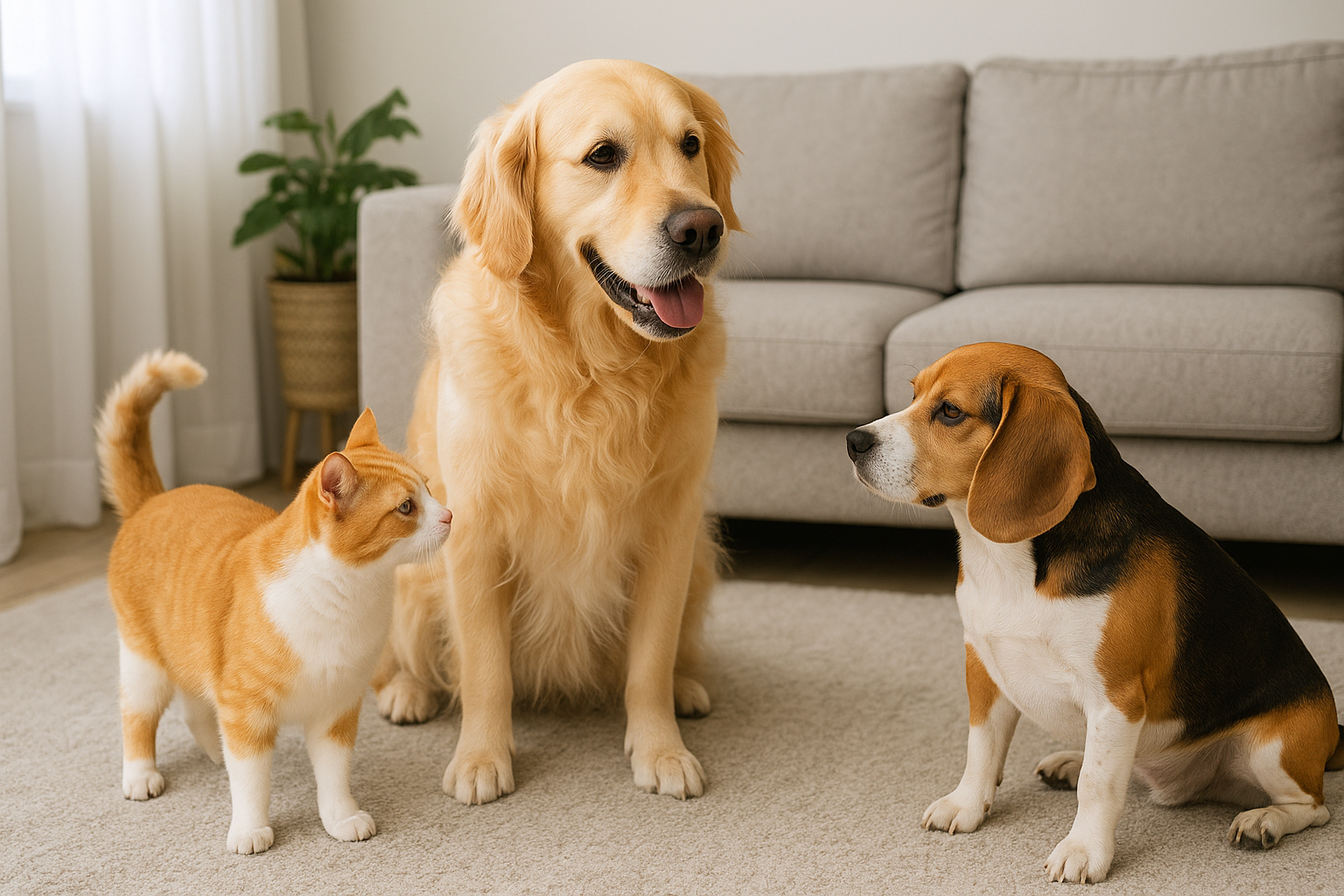Golden Retrievers are known for their friendly, sociable, and gentle nature, which makes them one of the best dog breeds for multi-pet households. Still, even a naturally sweet dog like a Golden needs a thoughtful introduction when meeting other pets—whether they’re cats, other dogs, or even small animals. A rushed or stressful introduction can lead to fear, tension, or long-term rivalry.
In this guide, you’ll learn how to safely and successfully introduce your Golden Retriever to other pets in your home.
Why Golden Retrievers Generally Get Along with Other Animals
Golden Retrievers have a long history as family dogs and working companions. They were bred to be:
- Calm and obedient
- Eager to please
- Gentle with animals and humans
- Non-aggressive and sociable
These traits make them naturally more adaptable when joining households with other pets. However, personality varies from dog to dog, and proper socialization and training still matter.
Preparing Your Golden Retriever for the Introduction
Before the first meeting, you want your Golden to be calm, responsive to commands, and in a relaxed mindset.
Steps to Take:
- Give your Golden plenty of exercise beforehand to release excess energy.
- Practice basic commands like “sit,” “stay,” “leave it,” and “come.”
- Set up physical boundaries using baby gates, crates, or exercise pens.
- Make sure your Golden is well-fed, relaxed, and not overly excited.
- Keep some high-value treats on hand to reward calm behavior.
Creating a calm, structured environment makes a huge difference in how your Golden responds to the new animal.
Introducing Your Golden to Another Dog
This is one of the most common introductions—and it’s also one of the easiest if handled correctly.
How to Do It Right:
- Meet in a Neutral Area: Start outdoors, like on a sidewalk or in a park.
- Walk Together at a Distance: Parallel walks help them feel each other’s presence without pressure.
- Watch Body Language: Look for wagging tails, sniffing, and relaxed postures. Avoid raised hackles, stiff legs, or growling.
- Gradually Allow Sniffing: Let them greet nose to rear, not face to face.
- Move to the Home: Once they’re comfortable, go inside—but keep the first few interactions supervised and brief.
Tips:
- Feed dogs separately to avoid food aggression.
- Separate sleeping spaces during the first week.
- If play gets too rough, calmly separate them.
Introducing Your Golden to a Cat
This introduction takes more patience. Cats are typically more territorial and less tolerant of fast-moving, curious dogs.
Steps for a Safe Introduction:
- Scent First: Swap blankets or toys between the cat and dog to get them used to each other’s scent.
- Visual Separation: Let them see each other from a distance using baby gates or a cracked door.
- Controlled Meetings: Keep your Golden on a leash while allowing the cat to approach (or retreat) freely.
- Use Positive Reinforcement: Reward your Golden when they stay calm in the cat’s presence.
- Give the Cat Escape Options: Cat trees, shelves, or safe rooms where the dog can’t go.
What to Avoid:
- Never let your dog chase the cat, even playfully.
- Don’t force proximity—let the cat control the pace.
- Avoid face-to-face introductions early on.
Some Golden Retrievers will quickly become best friends with a cat, while others may take weeks—or never fully bond. Coexistence is still a win.
Introducing Your Golden to Small Pets (Rabbits, Hamsters, Birds)
Small animals can trigger a dog’s prey drive, so you must proceed with extreme caution—even with a breed as gentle as the Golden Retriever.
Safe Practices:
- Keep small pets in secure enclosures during all interactions.
- Never leave your Golden unsupervised near small animals.
- Use commands like “leave it” and “stay” consistently.
- Allow brief, calm observation periods—reward your dog for ignoring the small pet.
- If your Golden shows signs of obsession or excitement, end the session immediately.
While true friendship between dogs and small pets is rare, peaceful coexistence is possible with structure and training.
Managing Jealousy and Resource Guarding
Adding a new pet can sometimes trigger insecurity or possessiveness, even in a well-adjusted dog.
How to Prevent Problems:
- Spend one-on-one time with each pet daily.
- Feed and give treats separately.
- Keep toys and sleeping areas personalized to avoid competition.
- Use praise and rewards to reinforce calm, non-jealous behavior.
Avoid punishing warning behaviors like growling—instead, redirect and create space when needed.
Signs of Trouble to Watch For
Even friendly animals can show signs of stress or discomfort.
Red Flags:
- Stiff posture, prolonged staring, or growling
- Obsessive focus on the other pet
- Hiding, loss of appetite, or sudden change in behavior
- Snapping or biting (even if it seems like play)
At the first sign of serious conflict, separate the pets and give them time apart. Consider seeking help from a professional trainer or behaviorist if issues persist.
Final Thoughts: One Step at a Time
With the right approach, Golden Retrievers can integrate beautifully into multi-pet homes. Their affectionate, tolerant nature gives them a great head start—but your patience, supervision, and guidance will make all the difference.
Take your time, celebrate small wins, and always prioritize safety. A well-managed introduction can lead to years of peaceful companionship—or even unexpected best-friend bonds across species.

